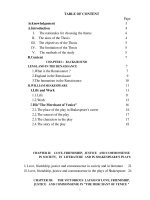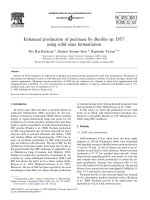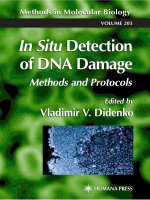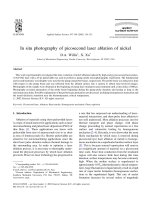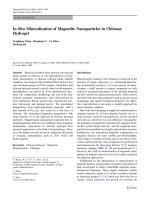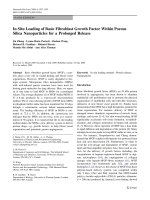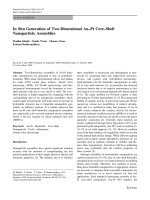In situ Bioremediation of chlorpyrifos by Klebsiella sp. Isolated from pesticide contaminated agricultural soil
Bạn đang xem bản rút gọn của tài liệu. Xem và tải ngay bản đầy đủ của tài liệu tại đây (287.63 KB, 12 trang )
Int.J.Curr.Microbiol.App.Sci (2018) 7(3): 1418-1429
International Journal of Current Microbiology and Applied Sciences
ISSN: 2319-7706 Volume 7 Number 03 (2018)
Journal homepage:
Original Research Article
/>
In situ Bioremediation of Chlorpyrifos by Klebsiella sp. Isolated from
Pesticide Contaminated Agricultural Soil
Elizabeth Mary John, Edna Mary Varghese, N. Krishnasree and M.S. Jisha*
School of Biosciences, Mahatma Gandhi University, Kottayam, Kerala - 686560, India
*Corresponding author
ABSTRACT
Keywords
Organophosphate
pesticides, Chlorpyrifos,
Bioremediation,
Bioaugmentation,
Klebsiella sp.
Article Info
Accepted:
12 February 2018
Available Online:
10 March 2018
Chlorpyrifos (O,O-diethyl O-3, 5, 6-trichloro-2-pyridyl phosphorothioate) is a widely used
broad-spectrum organophosphate pesticide. Widespread and indiscriminate use of
Chlorpyrifos has led to severe environmental problems. Bioremediation would be the only
eco-friendly solution for Chlorpyrifos persistence in the environment. Many bacteria are
capable of degrading Chlorpyrifos in liquid media. Thus, the current study attempted to
isolate Chlorpyrifos degrading bacteria from pesticide applied soil. The isolates were then
screened using HPLC analysis to calculate the percentage of pesticide degradation. The
isolate showing higher percentage of degradation was then morphologically and
biochemically characterized. Molecular identification included 16S rRNA sequencing and
phylogenetic analysis which revealed that the isolate showed close similarity to Klebsiella
sp. In situ bioremediation study in soil was carried out using the above isolate. The total
microbial count and the soil dehydrogenase activity in the bioaugmented treatment were
found to be higher compared to the treatment containing soil + Chlorpyrifos. Thus, it can
be inferred that the Klebsiella sp isolate was capable of degrading toxic Chlorpyrifos into
non-toxic products which increased the growth of soil microorganisms and dehydrogenase
activity.
Introduction
India is primarily an agriculture-based country
with more than 60-70 percent of its population
dependent on agriculture. Application of the
pesticide on agricultural crop is now a
common practice and is an important factor in
Integrated Pest Management (IPM) strategies.
They are used to reduce the losses caused by
pests, pathogens, weeds, mites, nematodes,
rodents thereby lower the cost of agricultural
products creating great economic benefits.
Organophosphate pesticides account for about
38% of total pesticides used globally. OPs are
a group of highly toxic chemicals that exhibit
broad-spectrum activity against insects and are
widely used against major agricultural pests.
Monocrotophos, quinalphos and chlorpyrifos
top the list of organophosphorus insecticides
in the Indian market.
Chlorpyrifos (CP) (O, O-diethyl O-3, 5,6trichloro-2-pyridyl phosphorothioate) is one of
the most frequently used chlorinated
organophosphate pesticides. The estimated
consumption of technical grade chlorpyrifos in
1418
Int.J.Curr.Microbiol.App.Sci (2018) 7(3): 1418-1429
India during 2002-03 was 5,000 MT (Singhal
V, 2003). It is a broad spectrum and
moderately toxic pesticide with trade names
Dursban, Lorsban and Spannit, with a half-life
(persistence) of 10-120 days in the
environment (Racke et al., 1990). It has a very
low solubility in water (2 mg/L) but is readily
soluble in most organic solvents and is used
for the control of major insects and pests
affecting a wide range of crops of cereals,
cotton and vegetables etc. (Wang et al., 2005).
can reduce significantly the toxicity of an OP.
Degradation
of
chlorpyrifos
using
conventional methods results in several toxic
products and accumulation of recalcitrant
residuals. Therefore, biodegradation using
native microorganisms for its removal from
the environment is quite attractive. Use of
pesticide-degrading microbial systems for
bioremediation, thus, receives attention
because of its cost-effectiveness and ecofriendly nature.
The environment can be thought of as
consisting of a series of compartments like
soil, water, air and other living organisms.
Approximately less than 0.1% of applied
pesticide reaches the target pest, leaving the
bulk to affect the environment. Pesticide
residues can adversely affect ecosystems,
causing serious environmental pollution. One
of the main environmental concerns with
pesticides is their potential to affect soil,
which is controlled primarily by their
persistence and mobility in the soil (Walker
A., 2003). Due to environmental significance
of pesticides and their residues, a thorough
understanding of the physical, biological and
chemical forces acting upon these chemicals is
important (Huang et al., 2000).
Several studies conducted in soil indicated
significantly longer dissipation half-lives
under sterilized versus natural conditions and
led to the conclusion that microbial activities
are important in the degradation of
Chlorpyrifos (Getzin, 1981; Miles et al.,
1979). Schimmel et al., (1983), based on
laboratory degradation studies with aqueous
solution and sediments, concluded that
microorganisms play an important role. Some
of the degrading bacterial genera include
Pseudomonas, Flavobacterium, Arthrobacter,
Alkaligenes, Staphylococcus etc.
These
pesticides
are
potent
acetylcholinesterase (AchE) inhibitors, and
various clinical effects can occur due to OPs
poisoning in humans. In humans, it causes
skin irritation, convulsion, twitching and rapid
contraction of muscles, depression, subtle
neurological effects, respiratory failures, and
death (Sogorb et al., 2004). CP was also found
to be toxic to aquatic life causing oxidative
stress, tissue damage and death. Delayed seed
germination occurs when plant seeds were
exposed to CP.
For all these factors degradation of
Chlorpyrifos is necessary. In general, only
hydrolysis of one of the phosphodiester bonds
Thus, the current study attempted to isolate
and characterize chlorpyrifos degradingbacteria
from
pesticide-contaminated
agricultural soil, to investigate their
degradation potential and to study their in situ
bioremediation
capability
using
soil
microcosms.
Materials and Methods
Isolation of chlorpyrifos degrading bacteria
Sample collection
Soil samples were collected from 4 different
parts of agriculture land where CP was
applied. They were collected from a depth of
10 cm. The collected samples were transferred
immediately to the laboratory for further
studies.
1419
Int.J.Curr.Microbiol.App.Sci (2018) 7(3): 1418-1429
Pesticide and media
The media used is Mineral Salts Media
(MSM) with the following components (gL-1):
K2HPO4 1.5, NaCl 0.5, MgSO4 0.2, FeSO4
0.02, CaCl2 0.05, pH 7.6 ± 0.2. All the
nutrients were sterilized by autoclaving at
1210C for 15 minutes. CP pesticide
formulation (Classic 20, 100w/w CP,
Cheminova) was filter sterilized and added to
the media aseptically, after sterilization, as the
sole source of carbon and nitrogen. Nutrient
broth is used during the screening process.
Isolation of CP degrading bacteria by soil
enrichment
10 gm of soil samples were weighed and
added to the Mineral Salt Medium (MSM)
supplemented with Chlorpyrifos (20 ppm). It
was incubated at room temperature in a shaker
at 120 rpm for 5 days. After 5 days of
incubation, soil samples were serially diluted
and were plated on nutrient agar and Mineral
Salt Agar medium having a 20 ppm
concentration of chlorpyrifos. After 24-48
hours of incubation, colony counts were taken.
10 ml from 20 ppm were added to another set
of MSM supplemented with Chlorpyrifos (40
ppm). The above procedure was continued
with increasing concentration of chlorpyrifos
(60, 80, 100 ppm). Morphologically distinct
colonies were selected, subcultured and
maintained on nutrient agar and mineral salt
agar slants.
Screening of CP degrading isolates
Screening of CP degradation by HPLC
100 mL nutrient broth was inoculated with
single colonies of selected purified strains and
was incubated overnight in a rotary shaker at
110 rpm for at 370C. Cells were harvested by
centrifugation at 40C at 10,000 rpm for 10
minutes to obtain the cells. The cell pellet was
washed with normal saline (0.89%) and
suspended in normal saline, vortex mixed and
centrifuged again as above. The pellet was
resuspended in 10-15 mL normal saline (this
method was followed for inoculum
preparation in later studies). The cell
suspension was used to inoculate flasks
containing MSM supplemented with 100 ppm
CP. The cultures were incubated at room
temperature for 6 days in a rotary shaker and
approximately 2 mL of sample is taken and
mixed it with 2 mL of dichloromethane. After
vortex mixing the extract was obtained by
filtration through Whatmann filter paper
containing sodium sulphate after evaporation
it was resuspended in 2 mL acetonitrile.
The biodegradation of CP was confirmed by
reverse phase liquid chromatography (RPHPLC) with C-18 column equipped with SPD
20 A UV detector (290 nm). The mobile phase
used was acetonitrile-water-glacial acetic acid
(82:17.5:0.5). The flow rate was 1mL∕ minute.
Data acquisition and processing were done by
using LC solution system software. The total
area of the peaks and the percentage of
degradation were calculated. By using the
formula:
Percentage of degradation (%) =
100 -
× 100
Identification of selected bacteria
The bacterial isolate showing higher
percentage of CP degradation was subjected to
morphological
and
biochemical
characterization as mentioned in Bergey’s
Manual
of
Systematic
Bacteriology.
Molecular identification of the isolate was
done using 16S rDNA typing and
phylogenetic analysis. The nucleotide
sequences were used for BLAST analysis
against the NCBI database to identify the
organism.
1420
Int.J.Curr.Microbiol.App.Sci (2018) 7(3): 1418-1429
In situ bioremediation study using soil
microbial microcosms
Experimental setup
Soil used for the experiment was collected
from agricultural soil which had no previous
exposure to CP. After the removal of plant
residues, samples were collected at a depth of
0.20 cm using a soil core sampler. The soil
was air-dried immediately after collection and
sieved to remove granule and plant residues.
CP commercial formulation following proper
dilution with distilled water was added to give
a final concentration of 100 mgKg-1 of soil.
Triplicate soil samples were prepared for three
sets of treatments: 1) Absolute control, 2) Soil
+ CP and 3) Soil+ CP + S6 (bacterial isolate).
Assay of potential dehydrogenase activity and
microbial population counts were done with
subsamples from the three treatments which
encloses 100 g dry weight of soil in each of
fifteen 250 mL conical flasks. Appropriate CP
formulations were added dropwise to triplicate
flasks to give selected CP concentration and
the gravimetric water content was maintained
at 16%. All soils were carefully mixed and
incubated in the dark at 150C. Microbiological
and enzymatic assay were done after 7th, 14th
and 21st days of incubation. Prior to
subsampling, the soil was thoroughly mixed.
During incubation, the soil microcosms were
weighed regularly, and weight loss was
compensated for by the addition of water.
Quantification of microbial population in
soil
Quantification of microbial population in CP
amended soil was done as per the method
proposed by (Alef and Nannipieri, 1995). 10 g
soil is suspended under aseptic conditions in
1g/mL tetrasodium pyrophosphate solution
(100 ml). After shaking for 30 min (150 rev
min-1) at room temperature, the supernatant
was transferred to a sterile measuring flask
and allowed to stand for 2-5 min. An aliquot
of clear supernatant was then removed and a
dilution series is prepared in decimal steps (up
to 10-7) were spread on complex agar plates
and incubated at 200C for 10 days. The plates
were examined at different intervals and
microbial colonies were counted and recorded.
Measuring dehydrogenase activity of soil
10 gm of air-dried sieved samples of soil was
weighed and placed in test tubes. 6mL freshly
boiled and cooled water was added to the soil
followed by 2 mL of 1% glucose and 2mL of
3% TTC solution. A tube of glucose, TTC
solution and water without soil serve as the
control. The tubes were then closed with
rubber bungs and incubated at 300C for 24
hours. At the end of incubation, the contents
of the tube were rinsed into a small beaker and
made a slurry by adding 10 mL of ethanol.
The slurry was then filtered through
Whatmann no 50 filter paper placed in
Buchner funnel using suction. The contents
were rinsed with methanol till the filtrate
becomes free of red colour. The filtrate was
then made up to 50 mL with methanol in a
volumetric flask and mixed well (Casida and
Jr, 1977).
The Optical Density (OD) of the coloured
solution was measured spectrophotometrically
using 546 nm wavelength and methanol as
reference blank. The concentration of
triphenyl formazon (TPF) present in the
extract was calculated by comparing the OD
with the standard curve. To prepare standard
curve, pipette 0, 0.5, 1, 2, 3 and 4 mL of TPF
standard solution in a volumetric flask (50
mL) and made up the volume with methanol
to obtain the following concentration: 0, 5, 10,
20, 30 and 40 mg TTF ml-1. A standard graph
was created by plotting concentration against
absorbance.
1421
Int.J.Curr.Microbiol.App.Sci (2018) 7(3): 1418-1429
Re-isolation of the isolate
Screening of primary isolates for
chlorpyrifos degradation by HPLC analysis
In order to check whether the isolate S6 could
survive in this soil an attempt to reisolate the
inoculated S6 from the treated soil was done.
Biochemical tests and antibiotic resistance
were employed for this. The different bacterial
colonies obtained from nutrient agar plates
after 21 days of incubation and S6 were
analysed by antibiotic resistance to Ampicillin
(A), Chloramphenicol (C), Ipemenem (Ipm)
and further confirmed by biochemical tests.
Statistical analysis
Statistical analysis of the results of soil study
was done using ANOVA and Karl Pearson's
correlation coefficient.
CP degradation analysis using HPLC
From the above mentioned three treatments, 2
gm of samples were weighed and mixed with
2.5 mL of acetone and water (9:1).
It was then centrifuged at 6000 rpm for 5
minutes. After centrifugation 2 mL of
supernatant was allowed to evaporate and it
was then redissolved in 2 mL acetonitrile. The
filtered sample was analysed by the HPLC as
mentioned above.
Results and Discussion
Isolation of CP degrading bacteria by soil
enrichment technique
Soil samples collected from 4 different fields
were enriched on Mineral Salt Medium
(MSM) containing 20 ppm, 40ppm, 60ppm,
80ppm and 100ppm of CP. Serial dilution and
spread plating was done to obtain growth on
CP agar plates. Colonies showing different
morphological characters were selected for
secondary screening. They were designated as
S1, S2, ……, S7.
Efficiency of chlorpyrifos degradation of
primary isolates was compared by HPLC
analysis of the extracts of CP-MSM medium
of the isolates after 6 days of incubation. The
area of the peaks of the control at a retention
time of 8.041 minutes was 124088. The isolate
S6 showed lower peak area at the
corresponding retention time (Fig. 1). The
percentage of degradation was calculated for
each isolate (Table 1). S6 showed higher
percentage of degradation (82.38%) and was
thus selected for further studies.
Identification of the isolate (S6)
The isolate showing higher percentage of
degradation in the HPLC analysis (S6) was
subjected to morphological and biochemical
characterization. The results corresponded to
the Genus Klebsiella. Molecular identification
was done by 16S rDNA typing. The result of
BLAST search of 16S rDNA compared with
the available 16S rDNA sequence in the
GenBank database indicated that the organism
was 99% similar to Klebsiella sp.
Phylogenetic tree based on 16S rDNA
sequences was drawn using neighbour joining
method showing the relationship between
Klebsiella sp. and representatives of related
genera. The tree was constructed using MEGA
5.22 after aligning the sequence with clustalW
(Fig. 2). From the phylogenetic tree it is
evident that the test isolate S6 is closely
related to Klebsiella sp MS6.
In situ bioremediation of CP using soil
microcosms
In soil microcosm experiments microbial
count and dehydrogenase enzyme assay were
done before and after CP exposure. CP mixed
soil was incubated for 7, 14 and 21 days.
Statistical analysis of the results was done
using two way ANOVA test (Table 2). The
1422
Int.J.Curr.Microbiol.App.Sci (2018) 7(3): 1418-1429
effect of bacterial count on CP concentration
was found to be statistically significant at 95%
confidence limits in most of the selected
treatments and all the treatments showed
correlation between soil microbial population
and dehydrogenase activity (Table 3). There is
a reduction inmicrobial count in the CP
amended soil compared to that of the control.
Whereas the soil containing S6 along with CP
showed increase in the bacterial count over the
period of time. In CP amended soil the
dehydrogenase activity was 0.295 mgmL-1 on
7th day which was reduced to 0.237 mgmL-1.
Bioaugmentation of CP amended soil gave
positive results in the case of dehydrogenase
activity. In soil amended with CP augmented
with the bacterial
isolate S6 the
dehydrogenase activity was 2.950 mgmL-1 on
7th day and 3.180 mgmL-1, 3.295 mgmL-1 on
14th and 21st day respectively (Fig. 3).
Reisolation
During the incubation period, the soil samples
were frequently checked for the presence of
the isolate S6.
Samples were serially diluted and plated to
confirm the survival and persistence of the
isolate in the treated soil. Suspected colonies
were checked by morphological analysis and
biochemical tests and confirmed by the
antibiotic susceptibility test (Fig. 4).
HPLC analysis
treatment soil
of
the
bioaugmented
In order to find out the extent of CP
degradation, HPLC analysis of the soil
samples from the bioaugmented treatment
were done on 0th, 7th and 14th days of
incubation. The CP peak areas were reduced
in the 7th and 14th day samples compared to
that of the control (0th day) confirming
degradation of CP by the isolate (Fig. 5).
Despite their toxic effects, pesticides are
extensively used and their usage has become
an inevitable agricultural practice in order to
obtain a good and constant yield. One of the
major environmental problems posed by
pesticides is their persistence. Chlorpyrifos,
being the commonly used one, is moderately
persistent in nature as its residues were
detected in soil even after 3 months (Chapman
and Chapnan, 1986). Hence, it is important to
develop methods to degrade CP into non-toxic
products.
Bioremediation using microorganisms is a
suitable approach as it is eco-friendly and
cost-effective. Many microorganisms have
been isolated, from nature, which have the
capacity to degrade chlorpyrifos and displayed
good degradation yields (Mukherjee and
Gopal, 1996; Mallick et al., 1999; Singh et al.,
2003).
Table.1 Percentage of degradation of chlorpyrifos by HPLC analysis by primary isolates
Primary isolates
Control
S1
S2
S3
S4
S5
S6
S7
Area
124088
95095
70033
67433
41144
47994
21869
25555
1423
% of degradation
23.37%
43.57%
45.66%
66.85%
61.33%
82.38%
79.41%
Int.J.Curr.Microbiol.App.Sci (2018) 7(3): 1418-1429
Table.2 Statistical analysis (two way ANOVA test)
Concentration
Days
Interaction
CD (0.05%)
Fungi
9.77
9.23
5.42
Bacteria
29.57
14.81
6.87
Actinomycetes
4.65
7.46
4.65
Table.3 Karl Pearson’s correlation coefficient between bacterial count and dehydrogenase
activity in soil microcosm study
Sl. No
Treatment
Correlation coefficient* (r)
7th
14th
21st
Absolute control
0.50248
0.76571
0.78525
1
Soil + CP
0.46603
0.27193
0.09647
2
Soil +CP+S6
0.76905
0.81281
0.89952
3
*All the treatments showed correlation at 0.05 levels of significance
Fig.1 HPLC chromatogram of control and S6 isolate after 6 days of incubation in MSM broth
supplemented with CP (100 ppm)
Control
Isolate S6
Fig.2 Molecular phylogenetic analysis of S6 using MEGA 5.22
1424
Int.J.Curr.Microbiol.App.Sci (2018) 7(3): 1418-1429
Fig.3 Dehydrogenase activity of soil after CP addition and bioaugmentation
Fig.4 Antibiotic sensitivity of the isolate towards selected antibiotics
Ipm – Ipimenem, A – Ampicillin, C – Chloramphenicol
Fig.5 HPLC analysis of soil + CP + S6 treatment samples at 0th, 7th and 14th day of treatment
imposition
0th day
1425
Int.J.Curr.Microbiol.App.Sci (2018) 7(3): 1418-1429
7th day
14th day
Both
abiotic
and
microbiological
transformation of chlorpyrifos have been
reported and are found Chlorpyrifos has been
reported to be degraded in liquid media by
Flavobacterium sp. (Sethunathan and
Yoshida, 1973), and Pseudomonas diminuta
(Serdar et al., 1982), which were initially
isolated to degrade other organophosphate
compounds. In the present study, CP
degrading isolates were isolated from
chlorpyrifos applied agricultural soil. The
isolation was done by soil enrichment with
increasing concentrations of CP. In this
medium, CP was the only carbon source and
the isolates that could survive in this medium
were those that could degrade CP. 7 colonies
(S1-S7) showing different morphological
characters were selected for secondary
screening by HPLC. Based on HPLC results,
isolate S6 showed higher percentage of CP
degradation (82.38%) (Table 1). The HPLC
chromatogram of S6 displayed reduced peak
area of CP from 124088 to 21869 within 6
days of incubation of the isolate in 100 ppm
CP (Fig. 1).
The organism was identified based on their
morphological, physiological and biochemical
characteristics and S6 was identified as
Klebsiella sp. The results of the 16S rDNA
gene sequencing, BLAST search and
phylogenetic analysis (Fig. 2) also supported
the morphological,
physiological and
biochemical identity of the isolate. Reports
state that Klebsiella sp. is capable of
degrading 2g/L and showed high tolerance to
CP (Ghanem et al., 2007). In a 2 months
study, 100% degradation was observed with
the survival of Klebsiella sp. (Akhtar et al.,
2004).
Due to the toxic properties, CP adversely
affects the growth of soil microflora and
reduces their count. The soil microcosm study
revealed the microbial strength and
dehydrogenase activity of the normal soil, CP
amended soil and CP along with S6. In soil
microcosm experiments, after the CP
exposure and incubation, soil samples were
collected periodically for doing, microbial
count, and dehydrogenase enzyme assay.
Complex agar media was used for recording
the total viable count of microorganisms from
CP amended soil and CP treated soil
augmented with S6. The complex medium
supported the growth of the entire selected
microorganism, such as bacteria, fungi and
actinomycetes. The microbial count and
dehydrogenase enzyme activity of the normal
soil has no significant variation in 7, 14 and
21 days of incubation. The dehydrogenase
activity of the CP amended soil was also
investigated and found that it was
progressively inhibited with increased
concentrations of CP. The dehydrogenase
activity of CP treated soil decreased
sequentially in 7th, 14th, and 21st days.
Whereas the S6 augmented CP amended soil
showed increased dehydrogenase activity
(Fig. 3). The normal soil possesses 0.434
1426
Int.J.Curr.Microbiol.App.Sci (2018) 7(3): 1418-1429
mgmL-1 dehydrogenase activity on 0th day.
This activity was reduced to 0.295 mgmL-1
when contaminated with CP due to their
adverse effects on the natural flora of soil
after the 7th day. The activity was further
reduced to 0.237mgmL-1 on the 21st day. The
introduction of the isolate S6 in CP amended
soil increased the amount of microflora in soil
and the dehydrogenase activity. This may be
due to the ability of the isolate to degrade CP
into non-toxic products which enabled the
microorganisms to grow and reproduce. The
introduction
of
S6
increased
the
dehydrogenase activity to 2.950 mgmL-1,
3.180 mgmL-1 and 3.295mgmL-1 on 7th, 14th
and 21st days respectively compared to the CP
amended soil. Also, the HPLC chromatogram
of the bioaugmented soil samples showed
reduction in CP concentration which proves
biodegradation (Fig. 5). In order to check the
correlation
of
bacterial
count
and
dehydrogenase activity the Karl Pearson’s
correlation coefficient (r) was calculated.
Statistical significance of calculated r was
assessed using the t- test procedure and all the
treatments showed correlation at 0.05 levels
of significance (Table 3)
and human health problems. Pesticides will
continue to be an indispensable agriculture
practice for the management of pests as there
are no possible alternatives to replace them.
Bioremediation is the only eco-friendly
solution to mitigate this pollution. Utilizing
microorganisms isolated from the pesticide
contaminated site would provide a fast in situ
degradation that will not only protect the soil
microbial population and enzyme activity but
also enhance them. The isolate Klebsiella sp.
isolated from chlorpyrifos-applied agricultural
soil, in the present study, was able to degrade
CP (25 – 100 ppm) in liquid media as well as
in the treated soil. Thus, the isolate can be
efficiently used for the remediation of
Chlorpyrifos in agricultural soil.
Persistent pesticide residues in the soil may
have a significant impact on soil microbial
population and their functions such as the
enzyme activity, which is directly related to
soil health and fertility and also to the
removal of contaminants (E.R Ingham et al.,
1991;Beare et al., 1992). These findings were
in agreement with the results of previous
studies done by Motonaga et al., (1996) in
which soil respiration and total bacterial
counts, as well as invertase, amylase,
dehydrogenase, and phosphatase activity,
were reduced following application of
chlorpyrifos.
Akhtar, Shahida, Syeda Talat, Shaheen
Gilani, and Nusrat Hasan. 2004.
Persistence
of
chlorpyrifos
and
fenpropathrin alone and in combination
with fertilizers in soil and their effect on
soil microbes. Pak. J. Bot 36 (4): 863–
70.
Alef, Kassem., and Paolo. Nannipieri. 1995.
Methods in Applied Soil Microbiology
and Biochemistry. Academic Press.
Beare, Michael H., Robert W. Parmelee, Paul
F. Hendrix, Weixin Cheng, David C.
Coleman, and D. A. Crossley. 1992.
Microbial and Faunal Interactions and
Effects on Litter Nitrogen and
Decomposition in Agroecosystems.
Ecological Monographs 62 (4).
Ecological Society of America: 569–91.
Widespread and indiscriminate use of
organophosphate pesticides, despite of their
toxic effects, has posed severe environmental
Acknowledgement
The authors are grateful to the Kerala State
Council for Science, Technology and
Environment
(KSCSTE),
Thiruvananthapuram, Kerala, India for the
financial support.
References
1427
Int.J.Curr.Microbiol.App.Sci (2018) 7(3): 1418-1429
Casida, L E, and Jr. 1977. Microbial
Metabolic Activity in Soil as Measured
by Dehydrogenase Determinations.
Applied
and
Environmental
Microbiology 34 (6). American Society
for Microbiology (ASM): 630–36.
Chapman, Ralph, and Phyllis Chapnan. 1986.
Persistence of Granular and EC
Formulations of Chlorpyrifos in a
Mineral and an Organic Soil Incubated
in Open and Closed Containers. Journal
of Environmental Science and Health,
Part B 21 (6): 447–56.
Ingham, E.R., R.Parmelee, David C.
Coleman,
Dac
Crossley.
1991.
Reduction of Microbial and Faunal
Groups Following Application of
Streptomycin and Captan in Georgia
No-Tillage Agroecosystems.
Getzin, L. W. 1981. Degradation of
Chlorpyrifos in Soil: Influence of
Autoclaving, Soil Moisture, and
Temperature1. Journal of Economic
Entomology 74 (2): 158–62.
Ghanem, I., M. Orfi, and M. Shamma. 2007.
Biodegradation
of
Chlorphyrifos
byKlebsiella Sp. Isolated from an
Activated Sludge Sample of Waste
Water Treatment Plant in Damascus.
Folia Microbiologica 52 (4): 423–27.
Huang, Xinjiang, Linda S. Lee, and Cindy
Nakatsu. 2000. Impact of Animal Waste
Lagoon Effluents on Chlorpyrifos
Degradation in Soils. Environmental
Toxicology and Chemistry 19 (12):
2864–70.
Mallick, K, K Bharati, A Banerji, N A Shakil,
and N Sethunathan. 1999. Bacterial
Degradation of Chlorpyrifos in Pure
Cultures and in Soil. Bull. Environ.
Contam. Toxicol 62: 48–54.
Miles, J. R. W., C. M. Tu, and C. R. Harris.
1979.
Persistence
of
Eight
Organophosporus Insecticides in Sterile
and Non-Sterile Mineral and Organic
Soils. Bulletin of Environmental
Contamination and Toxicology 22 (1):
312–18.
Motonaga, K., K. Takagi, and S. Matumoto.
1996. Biodegradation of Chlorothalonil
in
Soil
after
Suppression
of
Degradation. Biology and Fertility of
Soils 23 (3). Springer-Verlag: 340–45.
Mukherjee, Irani, and Madhuban Gopal.
1996. Degradation of Chlorpyrifos by
Two Soil Fungi Aspergillus Niger and
Trichoderma Viride. Toxicological &
Environmental Chemistry 57 (1–4):
145–51.
Racke, Kenneth D., Dennis A. Laskowski,
and Mark R. Schultz. 1990. Resistance
of
Chlorpyrifos
to
Enhanced
Biodegradation in Soil. Journal of
Agricultural and Food Chemistry 38
(6): 1430–36.
Schimmel, Steven C., Richard L. Garnas,
James M. Patrick, and James C. Moore.
1983. Acute Toxicity, Bioconcentration,
and Persistence of AC 222,705,
Benthiocarb, Chlorpyrifos, Fenvalerate,
Methyl Parathion, and Permethrin in the
Estuarine Environment. Journal of
Agricultural and Food Chemistry 31
(1): 104–13.
Serdar, C M, D T Gibson, D M Munnecke,
and J H Lancaster. 1982. Plasmid
Involvement in Parathion Hydrolysis by
Pseudomonas Diminuta. Applied and
Environmental Microbiology 44 (1).
American Society for Microbiology
(ASM): 246–49.
Sethunathan, N., and T. Yoshida. 1973. A
Flavobacterium Sp. That Degrades
Diazinon and Parathion. Canadian
Journal of Microbiology 19 (7): 873–
75.
Singh, Brajesh K, Allan Walker, J Alun W
Morgan, and Denis J Wright. 2003.
Effects
of Soil
pH on the
Biodegradation of Chlorpyrifos and
Isolation of a Chlorpyrifos-Degrading
Bacterium. Applied and Environmental
1428
Int.J.Curr.Microbiol.App.Sci (2018) 7(3): 1418-1429
Microbiology 69 (9). American Society
for Microbiology: 5198–5206.
Singhal V. 2003. Indian Agriculture. Indian
Economic Data Research Centre.
Sogorb, Miguel A, Eugenio Vilanova, and
Victoria
Carrera.
2004.
Future
Applications of Phosphotriesterases in
the Prophylaxis and Treatment of
Organophosporus Insecticide and Nerve
Agent Poisonings. Toxicology Letters
151 (1): 219–33.
Walker A. 2003. Adsorption and Degradation
from the Laboratory to the Real World.
In Pesticide in Air, Plant, Soil and
Water System. Proceedings of the X11
Symposium Pesticide Chemistry.
Wang, Lihong, Lin Zhang, Huanlin Chen,
Qingguo Tian, and Guonian Zhu. 2005.
Isolation of a Triazophos-Degrading
Strain Klebsiella Sp. E6 Effectively
Utilizing Triazophos as Sole Nitrogen
Source. FEMS Microbiology Letters
253 (2): 259–65.
How to cite this article:
Elizabeth Mary John, Edna Mary Varghese, N. Krishnasree and Jisha, M.S. 2018. In situ
Bioremediation of Chlorpyrifos by Klebsiella sp. Isolated from Pesticide Contaminated
Agricultural Soil. Int.J.Curr.Microbiol.App.Sci. 7(03): 1418-1429.
doi: />
1429

